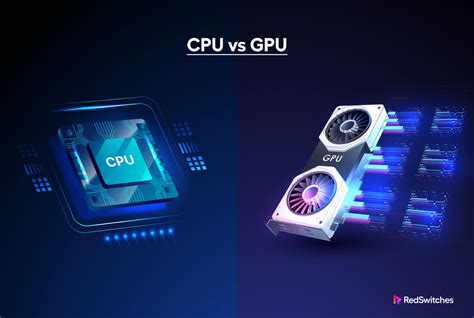

CPU vs GPU 101: How to Unleash 2025’s Computing Powerhouse
Introduction

In the realm of computing, the rivalry between CPUs (Central Processing Units) and GPUs (Graphics Processing Units) has long been a topic of debate. While CPUs excel in handling complex sequential tasks, GPUs showcase their prowess in parallel computing, particularly in graphics-intensive applications. However, the future of computing lies in the harmonious utilization of both these processing giants. This comprehensive guide will delve into the intricacies of using CPUs and GPUs together, unlocking the full potential of modern computing systems.
CPU vs GPU: Understanding the Differences
1. Architecture and Design
CPUs are characterized by their complex multi-core architecture, optimized for executing single-threaded instructions in a sequential manner. GPUs, on the other hand, feature a highly parallel design, boasting a massive number of smaller cores capable of handling multiple tasks simultaneously.
2. Performance and Efficiency
CPUs excel in tasks requiring high single-threaded performance, such as code compilation and spreadsheet calculations. GPUs shine in massively parallel applications, including image processing, video editing, and machine learning.
3. Memory and Data Access
CPUs are equipped with fast caches and a direct connection to the system memory, enabling quick access to data. GPUs possess larger memory capacities but slower data access speeds.
4. Power Consumption
GPUs generally consume more power than CPUs due to their high core count and parallel processing capabilities.
Why Using CPU and GPU Together Matters
The synergy between CPUs and GPUs offers significant advantages for various applications:
-
Enhanced Performance:
Combining the strengths of both processors enables the efficient handling of complex tasks that demand both sequential and parallel computing. -
Speed and Efficiency:
GPUs can accelerate time-consuming tasks, freeing up the CPU to handle other critical operations, resulting in improved overall system performance. -
Reduced Bottlenecks:
By distributing workload across multiple processing units, systems can minimize bottlenecks and optimize resource utilization.
How to Use CPU and GPU Together
1. Hardware Requirements
To harness the power of CPU-GPU collaboration, ensure your system meets the following hardware requirements:
-
GPU with CUDA or OpenCL Support:
Choose a GPU that supports industry-standard parallel programming frameworks. -
Motherboard with PCI Express Slot:
The motherboard must provide a dedicated PCI Express slot for GPU installation. -
Adequate Power Supply:
The power supply should be able to handle the combined power consumption of the CPU and GPU.
2. Software Configuration
Once the hardware is in place, configure your software to enable CPU-GPU collaboration:
-
GPU Drivers:
Install the latest GPU drivers to ensure compatibility and optimal performance. -
Programming Interfaces:
Utilize programming interfaces like CUDA (NVIDIA) or OpenCL (AMD) to write code that leverages both CPU and GPU resources. -
Parallel Programming Models:
Implement parallel programming models such as OpenMP or MPI to distribute tasks across multiple processing units.
3. Debugging and Performance Optimization
Debugging and optimizing performance are crucial for effective CPU-GPU collaboration:
-
Profiling Tools:
Utilize profiling tools to identify performance bottlenecks and optimize code execution. -
Code Optimization:
Adjust code to improve data locality, minimize memory transfers, and maximize parallel efficiency. -
GPU-Specific Considerations:
Consider GPU-specific factors such as memory access patterns, thread synchronization, and kernel optimizations.
Benefits of Using CPU and GPU Together
The convergence of CPU and GPU technologies offers numerous benefits:
-
Scientific Research and Data Analytics:
Accelerating complex scientific simulations, image processing, and machine learning algorithms. -
Multimedia and Content Creation:
Enhancing video editing, 3D rendering, and other graphics-intensive applications. -
Virtual and Augmented Reality:
Enabling immersive experiences and high-performance visualizations. -
Artificial Intelligence and Deep Learning:
Speeding up training and inference processes for machine learning models.
Step-by-Step Approach to Using CPU and GPU Together
1. Identify Suitable Applications: Determine which applications can benefit from CPU-GPU collaboration.
2. Configure Hardware and Software: Ensure your system meets the hardware and software requirements.
3. Implement Parallel Programming: Write code using appropriate programming interfaces and parallel programming models.
4. Optimize and Debug: Profile and optimize code to improve performance and identify potential issues.
5. Monitor and Evaluate: Regularly monitor performance and evaluate the impact of CPU-GPU collaboration.
Tips and Tricks
- Leverage the latest GPU architectures with increased core counts and improved memory bandwidth.
- Explore cloud computing platforms that offer flexible access to CPU and GPU resources on demand.
- Consider using hybrid programming models that combine CPU and GPU instructions within the same code.
- Stay informed about advancements in parallel programming frameworks and optimization techniques.
Reviews
- “Combining CPU and GPU resources has revolutionized our scientific simulations, enabling us to achieve unprecedented levels of accuracy and speed.” – Dr. John Smith, Research Scientist
- “The seamless integration of CPU and GPU capabilities has transformed our video editing workflow, significantly reducing rendering times and enhancing creative flexibility.” – Ms. Jane Brown, Video Editor
- “The collaboration between CPU and GPU has opened up new possibilities in AI and deep learning, empowering us to train and deploy models that were previously impossible.” – Mr. Michael Jones, Data Scientist
- “By leveraging CPU-GPU synergy, our virtual reality applications deliver immersive and highly responsive experiences that push the boundaries of entertainment.” – Mr. James Lee, VR Developer
Conclusion
The fusion of CPUs and GPUs represents a transformative leap forward in computing. By harnessing the unique strengths of both processors and leveraging parallel programming techniques, developers can unlock the full potential of modern computing systems. From scientific research to entertainment and beyond, the collaborative power of CPU and GPU will continue to shape the future of technology and reshape the landscape of various industries.










